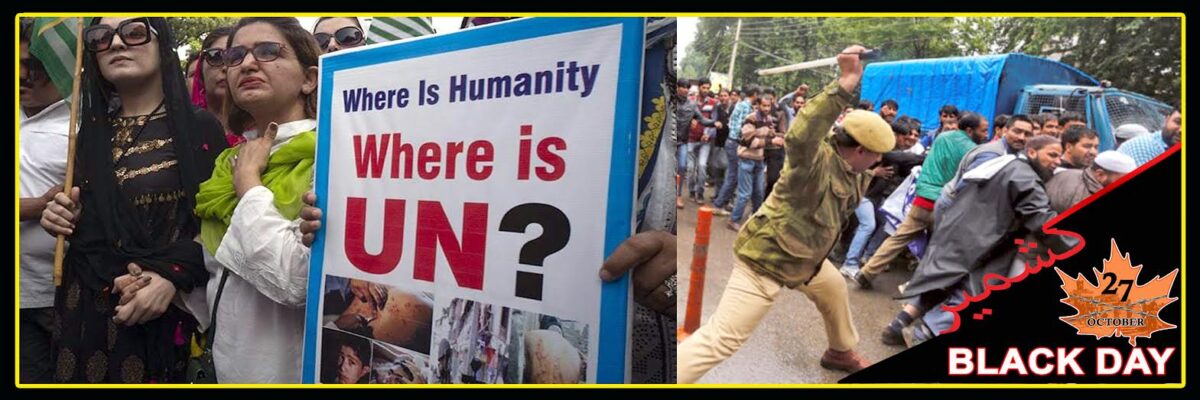The October 27, 1947 day, which will always be remembered by over thirteen million
Kashmiris all across the world as the Blackest Day in the Kashmir history. The misfortune
that afflicted Kashmiris on this day has not only made their lives miserable and panic it has
also endangered peace and security in the region with clear implications of a threat to world
peace. It is therefore, reasonably understandable that on this day Kashmiris look to the world
community longingly to come to their help in a big way to rescue them from their plight so
that peace and security is ensured in the region, which will certainly be a long-leap forward
towards the quest for universal peace.

This day, 75 years ago, the Indian armed forces landed, for the first time, on Srinagar airport
with the assigned task to rob Kashmiris of their birth right of self-determination, in blatant
violation of the terms of Partition Plan, the relevant provision of the Indian Independence Act,
the UN Charter and Universal declaration of Human Rights.
Indian military occupation of a major part of Jammu and Kashmir blatantly violated
both the first schedule of the Indian Independence Act and the terms of reference
of the partition plan.
The Indian Independence Act was passed by the British Parliament on July 18, 1947 under
which the Indian British Colony had to be divided into two sovereign states, the Hindu
Majority areas, state of India and the Muslim Majority areas, state of Pakistan. The objective
of the partition plan of June 3, 1947 was to divide the provinces in the west and Bengal in the
east, leaving Muslims majority areas in Pakistan and those with Hindu majority with India. Of
the main routes by which Kashmir could be reached, two roads passed through areas which
could be expected to be allocated to Pakistan: the first via Rawalpindi to Srinagar and the
other via Sialkot, Jammu and the Banihal Pass. A third route, which was no more than a dirt
track existed via, the district of Gurdaspor which comprised of four Tehsils of Shakargarh,
Batala, Gurdaspor and Pathankote. From Pathankote the route passed over Madophur
across the Ravi River to Kathua in the state of Jammu and Kashmir. Under the terms
provided in the first schedule of the Indian Independence Act, all the Gurdaspor district, with
a 51.14 percent Muslim majority had been assigned to Pakistan, which meant that all these
routes would have fallen under the control of Pakistan. This would have totally isolated India
from Kashmir, had there not been a Mountbatten-Radcliffe-Nehru combines’ perfidy to alter
the boundary award and give Gurdaspor district to India. Thus, the Indian military occupation
of a major part of Jammu and Kashmir blatantly violated both the first schedule of the Indian
Independence Act and the terms of reference of the partition plan.
Indian naked military aggression also trampled the provisions of the UN Charter
The Indian naked military aggression also trampled the provisions of the UN Charter, which
clearly states that, “member (states) shall settle their disputes peacefully and refrain from the
use or threat of force and interference in territorial unity and political independence of any
state”.
The universal Declaration of Human Rights, adopted on December 10, 1948 by the United
Nations General Assembly, mandated that “all human beings are born free and equal.
Everyone has the right to the life, liberty and the security of person. There must be no
slavery, servitude, torture, cruel, inhuman or degrading, treatment or punishment… No one
should be subjected to arbitrary arrest, detention or exile and everyone has the right to fair
trial. Everyone has the right to freedom of movement and the right to leave any country…
Kashmiris are being kept in slavery and servitude for the past 75 years
All these human rights, given protection in this Declaration, are being flagrantly violated by
the Indian occupation troops. Kashmiris are kept deprived of their right to self-determination.
They are being killed, tortured and deprived of their property. The women are harassed,
dishonoured and even imprisoned. Hundreds of innocent people have been indiscriminately
arrested on fake charges. Freedom of expression, movement, within their soil and abroad,
has been denied to them. They are being kept in slavery and servitude for the past 75 years.
Along with the military invasion, the Indian government had coerced the then Dogra
Maharaja of Jammu and Kashmir, Dogra ruler, Hari Singh, to accede to India. For this
purpose, an accession document, drafted in New Delhi, was presented to the Maharaja to
sign it. It is highly controversial whether the Maharaja did sign the document or not. There
are cogent arguments by authors of repute totally rejecting the Indian claim that the
document was duly signed by the state ruler. The strongest opponent of this claim is the
renowned British author, Alistair Lamb, who in his two books on Kashmir, has dwelt at
length on the falsity of this claim and insisted that it was never signed by the state ruler. He
has proved that the document was actually signed one day after the Indian invasion as the
occupation of Jammu and Kashmir by India preceded the signing of the document and had
no legal basis.
All the same, the then Indian government sent a fake document to the then Governor
General of India, Mountbatten who while accepting the accession, wrote to the Maharaja that
in the case of any state, where the issue of accession has been the subject of dispute, the
question of accession should be decided in accordance with the wishes of the people of the
state”. He added that the question of Kashmiris’ accession “should be settled by a reference
to the people”. Thus he signed the document provisionally, pending the final disposition of
the state by the people of Jammu and Kashmir.












